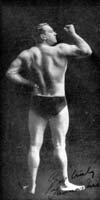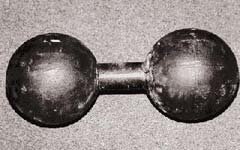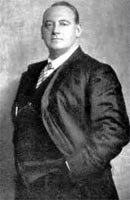In the February 22, 1913 issue of Health & Strength magazine in England, the Thomas Inch Challenge Dumbbell is referred to as famous. The bell, if my figures are correct, had been in existence for only seven years by that time. The author of the following is not credited from that issue:
-
"This dumbbell has become famous as the dumbbell which no man can lift (except, of course, its owner, Thomas Inch). It has been referred to as the 'lucky' dumbbell. The M.C. at a recent display was asked to explain how it came to be called 'lucky,' and he promptly replied, 'Well, you'll be lucky if you lift it."
Now notice that the bell may be soon retired from public opportunity: [it was not apparently retired until 1931, then brought out of retirement. And maybe used for WW II factory demonstrations. But by April 8, 1933, H&S was reporting that 'thousands' of men had tried and failed to lift the 172]. But the possible 1913 retirement was announced:
-
"We hear that it will be in evidence at the weight-lifting meeting at the London Weightlifting Club on Friday, Feb. 28. It is just possible that this will be its last appearance in public and the last occasion on which Mr. Inch will make his different offers to the man who should be fortunate enough to lift it."
The last statement was a reference to the cash that Inch had offered to those who could elevate the bell even inches off the floor. The text continues, and keep in mind the level of lifters who have failed with it, and who is NOT mentioned as having failed with it, among the 2,000 or so men who have "...tried and failed, including among the better known- i.e., the ones with titles- Edward Aston, Maurice Deriaz, W. Harwood, Strongfort (from Denmark, not America), W. Caswell, S. Croft, etc. etc."
Was Saxon among the etc. etc.? If one wished to show the utter challenge this bell was to lift, then why not list Saxon among 'those with titles'? Inch does not mention in print (that I have located) any mention of Saxon failing with the bell until after Saxon passed away.
Was there anyone more of a scientific lifter than Saxon? Why was Inch worried about the general herd of lifters if Saxon failed with the 172? Indeed in another place Inch uses Saxon as his brute barometer and says that because Saxon failed with the 172, Inch felt confident that he was safe in offering cash to lesser men.
In regard to the men listed however:
"When the above made their attempts, Mr. Inch's offer was L50 (fifty pounds British money) and L1000(sic) but now that such progress has been made in the science of lifting..." the prizes were reduced to "the man who lifts it in the same way that Mr. Inch does..." or to an amateur "lifting it to his knees." The reward was lowered to L25 for a pro and a similar value clock for an amateur.
A man named C. Maw was mentioned -
-
"It seems for several years [so how long?] Maw has been giving an exhibition with a similar dumbbell to Mr. Inch's, and for some months has specialized on the lift, and he backs his confidence by traveling a journey of 500 miles (total) to make the attempt."
Special mention was made to include Edward Aston in the challenge. (Again, was it expected that some men might be able to elevate the bell a few inches but that Saxon could never get it off the floor? This is insulting to anyone who knows lifting history.
Especially in view of the assertion by Inch that Arthur tried for fifteen YEARS and never succeeded, even though Inch himself claims to have mastered it in about six to ten years. If you believe that is possible, then there really is no point in you reading any more of what follows. David Willoughby, strength historian considered it 'unthinkable' that Saxon take a back seat to Inch in grip strength.)

Inch's Trick Lift; Aston's Counter-Challenge
Aston replied in the March 1, 1913 issue of H&S:
-
"Re: Inch's dumbbell challenge, I thought I had made it clear that I did not want challenges directed at me for exhibition TRICKS [my emphasis], but Inch is so persistent in this direction that I will accept his L25 offer, and now do so conditionally on his making an attempt to lift a dumbbell that I shall bring with me."
Remember that Aston was in Inch's employ for some time and that Aston had frequent occasion to try all of Inch's four bells, and never could master the 172, so why did he feel confident that Inch would fail one-handed with a dumbbell that he (Aston) provided? This was to be a plate loaded dumbbell, with standard bar.
-
Aston continues:
"I will lift my dumbbell with one hand and lower it with one, and will leave it lying there for Inch to follow suit, and shall be glad if he will leave his in a like manner for me to lift."
One of the tricks of old-time strongmen was to lift a lighter, hollow, weight and carry it off stage into the wings, then come back on stage with an identical, but solid weight, and then make a challenge to the audience to lift what they [thought they] had just seen the strongman lift.
 |
Switching Weights: This practice began, at least in France with a man named Wolff who billed himself as 'The Rock of Luxembourg' and who Prof. Desbonnet refers to as '...the first to use phony weights in France." Some of Wolff's weights were actually half their claimed poundage. |
 |
 |
||
Two important points in Aston's challenge, in which of course, he knew he would fail with the Inch 172. He was confident that Inch would also fail with the dumbbell that he planned to bring. Why? For one thing Aston was better at the one hand clean than Inch, and laid this stipulation as part of his own challenge: one hand up, one hand down, leave it sitting there, no bell switching.
Aston made Inch an offer of L50- twice what Inch was offering for success with his bell! Aston was not a fool, and given his years of acquaintance with Inch and the bells, must have felt his money was very safe because of either Inch's weakness, or the stipulation that Inch's bell remain in sight on stage.
Does this not appear to imply that Inch was using two hands to get his bell to the chest? Or that if he were using one hand for the clean then Aston suspected Inch was switching to one of the lighter bells?
Now regarding Feb 28, 1913, H&S covered the event in the March 8th issue: And I admit that this puzzles me because of missing details. Was it two hands? Which lift? The text:
Inch "lifted his famous dumbbell without the slightest difficulty. E. Aston, W. Watson, A.C. Maw, and several amateurs, amongst them an Indian gentleman, all tried to lift the dumbbell, but none were (sic) successful." That was on page 260.
Six pages later Aston relates how Inch claims that he was lifting injured, but still tries to break records. Aston sees this as a no-win situation for himself. If he wins he has defeated an injured man. If he loses 'a cripple will have defeated me'.
Aston's strength level as of March 13, 1913 was a one hand clean of 250.5 lbs! And in the November 15, 1913 issue of H&S the published list of Official British Weightlifting Records gives two to Inch (both overhead movements) and a dozen to Aston.
Inch lifted it 'without the slightest difficulty'? Which lift? What happened to Aston's dumbbell challenge to Inch? Too many missing details. And my collection lacks many of the issues of H&S from this time period. (can anyone fill in the gaps here?)
In the January 17, 1914 issue Aston writes a letter to the editor to demonstrate the extreme measures Inch will take to be recognized as the champion:
"Sir, Lately several references have been made with regard to Inch's lift of 304-1/2 lb, all of which refer to it as a single-handed lift, and it's being described as such is likely to cause confusion with my own single-handed lift of 300-1/2 lb. Inch's single-handed lift stands at 245-3/4 lb.
"His 304-1/2 lb. lift was done by taking the weight with two hands to the shoulder and then bent pressing it overhead. Only those weights lifted all the way with one hand can justly be described as single-handed lifts. My 300-1/2 lb. was a genuine single- handed lift, inasmuch as it was lifted all the way with one hand.- Yours faithfully, E. Aston."
In a monumental example of doublespeak to H&S, the referee of Inch's lift, Mr. Croft 'has described it to us as a single-handed bent press from the shoulder two hands being employed to raise it to the shoulder. It was a single-handed overhead bent press." Anybody ever heard of a double-handed overhead bent press"? THAT would take flexibility!
The point of all this is to show that Inch would stoop so far as to re-name lifts so he could reclaim records in that lift, even though he violated the rules and was not in fact performing the lift for which he seeks the record! Sorta like deadlifting to gain the bench press record... Is it such a surprise that someone who would misrepresent lifts in this way, would also misrepresent which of his four bells he was lifting?
David Prowse wrote to me when I was publishing MuscleSearch, The Roark Report: His letter dated April 17, 1989 from which this excerpt:
-
"...and to be perfectly honest, I am very skeptical as to whether Inch ever lifted the dumbbell successfully himself. I say this because Edward Aston, who worked for him, told me when Inch was challenged to lift the dumbbell he ALWAYS [emphasis mine] substituted one of the lighter ones, as they all looked similar."
I am missing most of the issues of H&S from 1914 to 1920, so ignorance is all that I can offer from that period. In 1920, however, Inch tried to make a comeback at age 38.
Then in 1921 in the November 26th issue of H&S Inch wrote about some of the strongmen he had known. He mentions that John Grun Marx never attempted to lift the 172, but that Arthur Saxon, who co-incidentally had died three months before this was penned by Inch:
-
"But, on the other hand, Saxon was even stronger than Marx, and had a huge hand and was also used to lifting thick bars; and, as he could do nothing with my dumbbell, I fail to see where Marx's chance came in."
Marx's chance came in because he had deadlifted the 226 lb Desbonnet dumbbell which had a handle of 2.36" instead of the 2.38" of Inch's 172 bell. The diameter is not a factor when 54 pounds less is being lifted on a bar only .02" thicker! And remember Inch did not list Saxon among those who failed with the 172 when Saxon was living!
Marx had died in 1912. Inch also claimed that the other Saxon brothers, Hermann and Kurt repeatedly failed with the bell. Inch added that the Saxons had a bell similar to his made, and took it on tour offering money to anyone able to lift it.
The Saxons mastered their own bell but when they returned to try Inch's 172 after the tour, they all again failed. Isn't this wonderful fiction! Arthur's hand length at 9" would have negated the thick handle, and his hand width, we now know, was not a hindrance. In my view, Saxon would have handled the 172 with success.
Marx's hands were 8.5" long. Other feats ascribed to Marx show that he would have lifted the Inch 172 if given a chance; to wit: Marx one hand snatched 154.25 lbs on a bar whose diameter was 2.75" (much thicker than a modern 12 ounce can of soda or beer). And Marx himself offered for challenge a couple of dumbbells, whose weights were 132 and 143 lbs, each bell having a handle diameter of 2.75" which was wrapped in metal foil to make it even more slippery.
It is generally conceded that Marx was second only to Apollon in all round hand/grip strength. The 226 lb bell with 2.38" handle that Marx could deadlift with one hand, Apollon tried to snatch with one hand, but lost his grip as the bell was going overhead and the bell landed (not rolled) several feet behind him. Marx, and Apollon, whose hand length was nine inches, would have toyed with Inch's 172.
Regarding Marx, Inch wrote,
-
"Personally, I don't think he could have lifted it, though I remember Pevier once told me that he would have swung it."
The reference is to 'The Swing' lift, in which one could always lift less than in the clean, so Tom Pevier meant that Marx would have had no difficulty in cleaning the 172.
For reference, here is a list of those who tried and never tried, to lift the 172:
Those Who Inch Claim Failed:
- Maurice Deriaz
- Strongfort (Denmark)
- Edward Aston
- Harold Wood
- Max Sick
- Monte Saldo
- Hindoo wrestler 6'6"
- Padoubny
- Wilfred Diamond
- Hackenschmidt??
- Sandow??
- Saxon??
Those Who Never Tried:
- Apollon
- Primo Carnera
- Manger
- John Grunn Marx
- Leon See
- Jim Pedley
- Louis Cyr
- Vansittart (Vansart)
- Batta
- Saxon (belongs in this list in my view)
- Vandernocke
As any strength fan knows, the 'never tried' list contains the very names of the strength athletes MOST LIKELY to succeed with the 172! These were the grip masters of the day.
Inch's deliberate confusion regarding which bell was being lifted would return to haunt him as we shall see in future installments.





